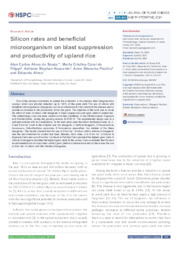Silicon rates and beneficial microorganism on blast suppression and productivity of upland rice.
Silicon rates and beneficial microorganism on blast suppression and productivity of upland rice.
Autoria: SOUZA, A. C. A. de; FILIPPI, M. C. C. de; NASCENTE, A. S.; PRABHU, A. S.; ALVES, E.
Resumo: One of the primary constraints in upland rice cultivation is the disease blast (Magnaporthe oryzae), which can provide reduction up to 100% of the grain yield The use of silicon with benefi cial microorganisms (bioagents) can be an alternative for the control of this disease and to provide an increase in the productivity of the rice grain. The objective of this work was to study the eff ect of rates of silicon with bioagents in blast suppression and grain yield of upland rice. The methodology used was tests carried out in field conditions, in two different areas: Capivara and Palmital farms, during the growing season 2015/2016. The experimental design was in a split-plot scheme with four replications. In the main plots were the silicon fertilization rates (0, 2, 4 and 8 ton ha-1) and in the subplots was the bioagents (1-without bioagents, 2-Pseudomonas fluorescens, 3-Burkholderia pyrrocinia, 4-Trichoderma asperellum, 5-a mixture of the three bioagents). The results showed that the use of 2 ton ha-1 of silicon with a mixture of bioagents was the best treatment to control leaf blast. Besides, from rates, 2 to 6 ton ha-1 of silicon in Capivara Farm and up to 8 ton ha-1 of silicon in Palmital Farm provided the highest grain yield. A mixture of bioagents provided the highest grain yield. In this sense, it was concluded that the best recommendation to connect blast control, grain yield and reduced amount of silicon was the use of 2 ton ha-1 of silicon with the mixture of bioagents.
Ano de publicação: 2021
Tipo de publicação: Artigo de periódico
Unidade: Embrapa Arroz e Feijão
Palavras-chave: Arroz, Brusone, Magnaporthe oryzae, Microorganisms, Microrganismo, Oryza Sativa, Rice, Silicon, Silício
Observações
1 - Por padrão são exibidas publicações dos últimos 20 anos. Para encontrar publicações mais antigas, configure o filtro ano de publicação, colocando o ano a partir do qual você deseja encontrar publicações. O filtro está na coluna da esquerda na busca acima.
2 - Para ler algumas publicações da Embrapa (apenas as que estão em formato ePub), é necessário ter, no celular ou computador, um desses softwares gratuitos. Sistemas Android: Google Play Livros; IOS: iBooks; Windows e Linux: software Calibre.
Acesse outras publicações
Acesse a Base de Dados da Pesquisa Agropecuária (BDPA) para consultar o acervo completo das bibliotecas da Embrapa.

